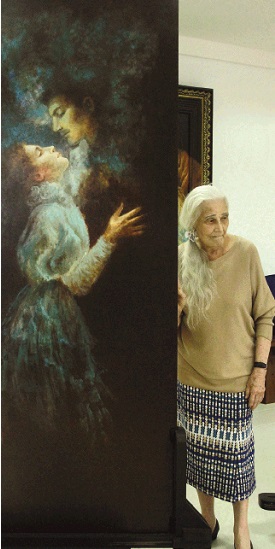At 94, artist Elena “Morita” Roces continues to live a colorful life, so much so that even death should be equally colorful—quite literally. She wants to change the world’s view of death not as a void, but as a happy transition to the next soul journey.
Her cremation urns continue to be top-sellers in her repertoire of decorative arts, which includes doors, tableaux and furniture and even pews. Unlike the boring urns sold in funeral parlors, Morita’s containers are definitely not for the shy.
Despite weak eyesight, she manages to produce flamboyant works of art. In her workshop in Mandaluyong, Morita sketches and shows photographs from books and guides her artisans.
One of Morita’s influences is Austrian symbolist painter Gustav Klimt, who in turn was inspired by Byzantine mosaic and Impressionist painters.
Using various media such as papier-mâché, wood, acrylic and oil, Morita and her workers enhance the urns with mini-sculptures, semi-precious stones and jewelry.
Like Klimt’s paintings, some urns have hints of gold, bubbly scribbles and ornately patterned surfaces. The beauty of the cremation urns lies in the dynamic lines and brilliant colors.
The urns are customized to suit the personality of the departed soul.
Some designs can be as traditional as butterflies flying in infinite space, or as modern as art nouveau geometric figures, encrusted with crystals and stones.
Morita is from one of the country’s prominent families. Her father, Don Ramon Roces, founded the “komiks” industry under Liwayway Publications and the Manila Times. Her mother, Elena Hollman, died when Morita was a child.
Morita was raised by an English nanny and sent to boarding school in London.
Upon returning to Manila, she took up painting lessons with National Artist Vicente Manansala.
Barely out of her teens, she married Dr. Mario Guerrero, the brother of writer Carmen Guerrero Nakpil, and bore him three children.
Through the years, she has experimented with various creative endeavors, from baking to designing clothes and painting while running the family business.
She also lived in Spain to raise her children and came back to the Philippines in the 1990s.
In 20 years, Morita has experimented with religious tableaux, jewelled rosaries and functional art.
She has also made coffins, which only the extremely rich could afford.
Today, she keeps her real estate business and does what she loves most: the art of living.
